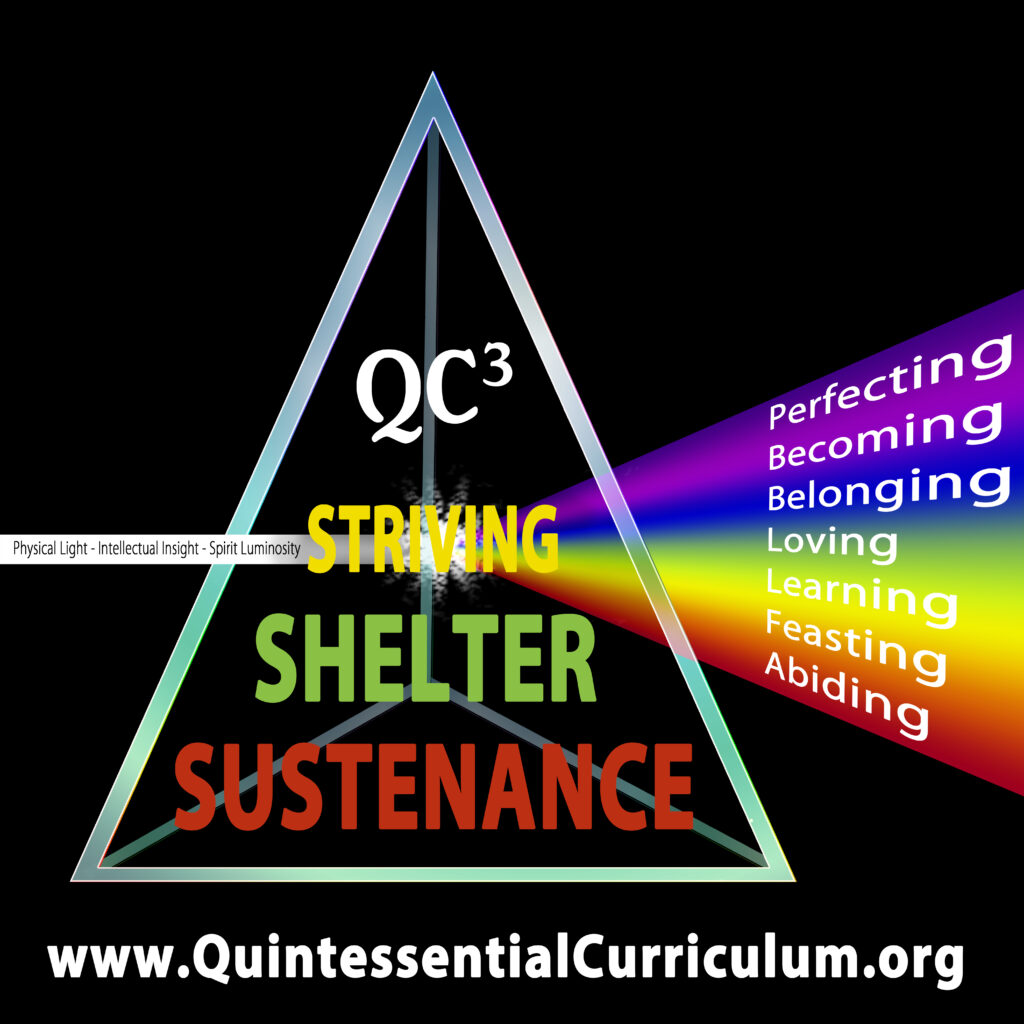Many writers have described Aristotle’s fifth element as a kind of invisible light or fire. In the Middle Ages. The quinta essentia has evolved to stand for anything so perfect that it seems to surpass the limitations of earth. Today we generally use quintessential rather freely to describe just about anything that represents the best of its kind.
As we each develop a new and enhanced vision for our lives, the facts, meanings, and values that challenge our world views inform our decisions. It is these decisions that move us away from spiritual stagnation as they serve to cultivate growth of the immortal soul.

The prismatic graphic above represents our interpretation of Abraham Maslow’s hierarchy of needs as presented in his 1943 paper “A Theory of Human Motivation.” Our view is informed by three distinct kinds of light: Physical Light, Intellectual Insight, and Spirit Luminosity. Depicted within the prism is the foundational triad widely held to be essential for addressing our physical needs. Arrayed within the rainbow to the right of the prism are the elements of what has come to be known as the virtuous cycle. This cyclical process, of personal and spiritual growth, feeds the immortal soul.
Practical Striving
In the quintessential curriculum, nurturing ambition and fostering personal growth are paramount. Strivings encompass the range of aspirations that drive individuals towards self-improvement and success. This subtopic delves into the essential role of cultivating ambition within educational settings. By encouraging students to set meaningful goals, educators help them develop a sense of purpose and direction. The quintessential curriculum recognizes that ambitions can vary widely among individuals, from academic pursuits to creative endeavors or community engagement.
It emphasizes the importance of providing ample opportunities for students to explore their passions and interests. Moreover, nurturing ambition involves fostering resilience and perseverance. The quintessential curriculum instills a growth mindset, teaching students that setbacks are learning opportunities rather than failures. It equips them with valuable skills such as problem-solving, adaptability, and goal-setting strategies.
Practical Shelter
In the pursuit of knowledge and personal development, it is paramount to acknowledge the significance of shelter as a fundamental element in the quintessential curriculum. Shelter, beyond being a basic human necessity, serves as a haven that nurtures physical and emotional well-being. It provides protection from external elements, ensuring safety and security. Furthermore, shelter creates an environment conducive to learning and growth by offering a space for solitude, concentration, and self-reflection.
Within the realm of education, shelter encompasses more than just physical structures; it encompasses a sense of belonging and comfort. A welcoming classroom or study area can instill a sense of calmness and promote focused attention among learners. Additionally, providing students with safe spaces where they feel supported encourages them to express their thoughts freely and engage actively in their educational journey.
Practical Sustenance
Sustenance is a fundamental aspect of the quintessential curriculum, encompassing the knowledge and skills required for survival and well-being. In this context, sustenance encompasses more than just food and water; it includes essential life skills such as nutrition, hygiene, and basic healthcare. Teaching individuals how to provide for their physical needs lays the groundwork for a healthy and thriving society. By incorporating sustenance into the curriculum, we equip students with practical knowledge that can benefit them throughout their lives.
For instance, understanding proper nutrition empowers individuals to make informed dietary choices, leading to improved overall health. Furthermore, teaching basic healthcare practices can help prevent illness and promote wellness within communities. In addition to its direct impact on individual well-being, sustenance education fosters self-reliance and resilience. It empowers individuals to navigate challenging situations by providing them with tools to meet their own needs.
